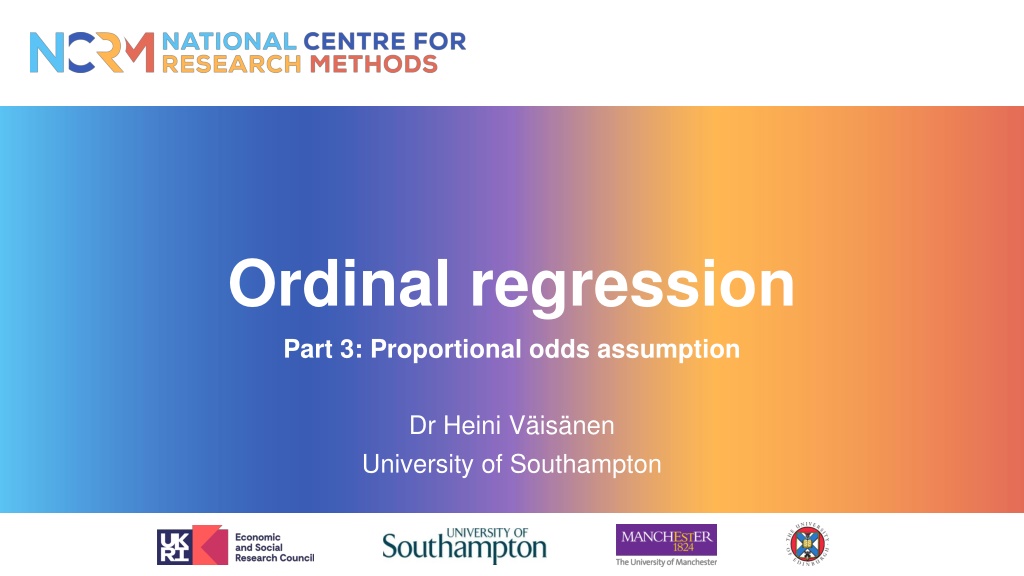Understanding Proportional Odds Assumption in Ordinal Regression
Exploring the proportional odds assumption in ordinal regression, this article discusses testing methods, like the parallel lines test, comparing multinomial and ordinal logistic regression models, and when to use each approach. It explains how violating the assumption may lead to using the multinomial model and the implications of not adhering to this assumption. Additionally, it presents alternatives for assessing the assumption and highlights the trade-offs in using the multinomial logit model for categorical responses.
- Proportional Odds Assumption
- Ordinal Regression
- Multinomial Logistic Regression
- Parallel Lines Test
- Covariates
Download Presentation

Please find below an Image/Link to download the presentation.
The content on the website is provided AS IS for your information and personal use only. It may not be sold, licensed, or shared on other websites without obtaining consent from the author. Download presentation by click this link. If you encounter any issues during the download, it is possible that the publisher has removed the file from their server.
E N D
Presentation Transcript
Ordinal regression Part 3: Proportional odds assumption Dr Heini V is nen University of Southampton
Outline Proportional odds assumption Meaning Testing A comparison of multinomial and ordinal logistic regression models
The proportional odds assumption The assumption of a common slope b implies that the effect of x is the same for each cumulative logit, i.e. regardless of k. We can test this assumption. If we find it does not hold, we should treat y as nominal and use the multinomial logit model: test of parallel lines H0: The slopes do not differ. H1: The slopes are different.
The proportional odds assumption: test of parallel lines H0: The slopes do not differ. If we fail to reject the H0 (i.e. if the p-value is large), we conclude that the proportional odds assumption is reasonable and we can use the ordinal model. H1: The slopes are different. If we do reject the H0 (i.e. if the p-value is small), we conclude that the proportional odds assumption is not reasonable and we cannot use the ordinal model.
The proportional odds assumption: test of parallel lines using omodel in Stata H0: The slopes do not differ. H1: The slopes are different.
The proportional odds assumption: test of parallel lines using omodel in Stata H0: The slopes do not differ. H1: The slopes are different. NB! Not everyone is a fan of this test. I will show you an alternative albeit informal way of examining the assumption using a multinomial model.
Comparing Multinomial and Ordinal Logistic Regression In a multinomial logit model, we model the response probabilities. We take one category as the reference. We then estimate pairwise contrasts between each response category and this reference. Unlike in an ordinal model we are not making the proportional odds assumption, so the results will always be more precise when using a multinomial model
Why Not Always Use the Multinomial Logit for Categorical Responses? Having a different set of coefficients in each equation, the number of parameters will be larger (i.e. less parsimonious). Interpretation-wise, there are no common effects across the level of the covariates. If the response is ordinal start with the cumulative logit model. Only consider the multinomial logit model if the proportional odds assumption is invalid.
Multinomial vs. ordinal and the proportional odds assumption Not very vs. not at all worried Men (ref.) Women No education (ref.) O-level/GCSE A-level Degree or diploma OR P-value Fairly vs. not at all worried Men (ref.) Women No education (ref.) O-level/GCSE A-level Degree or diploma OR P-value 1.00 1.22 1.00 1.88 1.61 1.85 1.00 1.56 1.00 1.58 1.32 1.30 0.114 0.002 Very vs. not at all worried Men (ref.) Women No education (ref.) O-level/GCSE A-level Degree or diploma OR P-value 0.002 0.012 <0.001 0.033 0.177 0.130 1.00 1.66 1.00 1.13 0.63 0.47 0.005 0.614 0.079 0.001
Multinomial vs. ordinal and the proportional odds assumption using predicted probabilities Multinomial model, probabilities for women Ordinal model, probabilities for women Not at all Not very Fairly Very worried Not at all Not very Fairly Very worried No education 16.4% O-level A-level Degree No education O-level A-level Degree 36.8% 45.7% 47.4% 52.2% 28.7% 29.9% 30.4% 28.6% 18.1% 13.5% 9.1% 6.7% 11.4% 11.6% 13.8% 15.2% 43.9% 44.1% 46.7% 48.0% 31.4% 31.2% 28.5% 26.8% 13.2% 13.1% 11.0% 9.9% 10.8% 13.1% 12.6%
Example from video 1 a well fitting ordinal model Predicted probabilities from a multinomial model (and an ordinal model in parentheses) Likelihood to apply for PG Parents not educated Parents educated Unlikely Somewhat likely Very likely 0.59 (0.59) 0.33 (0.33) 0.08 (0.08) 0.32 (0.32) 0.48 (0.43) 0.21 (0.25)
Summary You can use either ordinal or multinomial models for ordered multi- category outcome variables Ordinal model is more parsimonious than the multinomial model, but makes the proportional odds assumption If this assumption is not met, you will have to use a multinomial model If the assumption is met, it is better to use the more parsimonious ordinal model You can formally test the assumption and/or compare predicted probabilities between multinomial and ordinal models























